Analysis of Walt Disney's Entrepreneurial Success Factors
VerifiedAdded on 2023/06/12
|14
|3969
|117
Case Study
AI Summary
This case study provides an in-depth analysis of Walt Disney's entrepreneurial journey, highlighting his unwavering spirit, innovative ventures, and influential leadership. It examines his early struggles, the creation of iconic characters like Mickey Mouse, and the establishment of Disneyland as a major entertainment empire. The analysis delves into Disney's motivating factors, including his ability to overcome adversity and his dedication to creating a fantasy world for others. It further explores his entrepreneurial orientation, emphasizing his risk-taking abilities, creative vision, and commitment to continuous improvement. The study also assesses Disney's leadership qualities, which were instrumental in fostering a talented team and driving the company's growth. Ultimately, the case study concludes that Walt Disney's unique characteristics and entrepreneurial spirit were crucial in establishing The Walt Disney Company as a global leader in the entertainment industry.
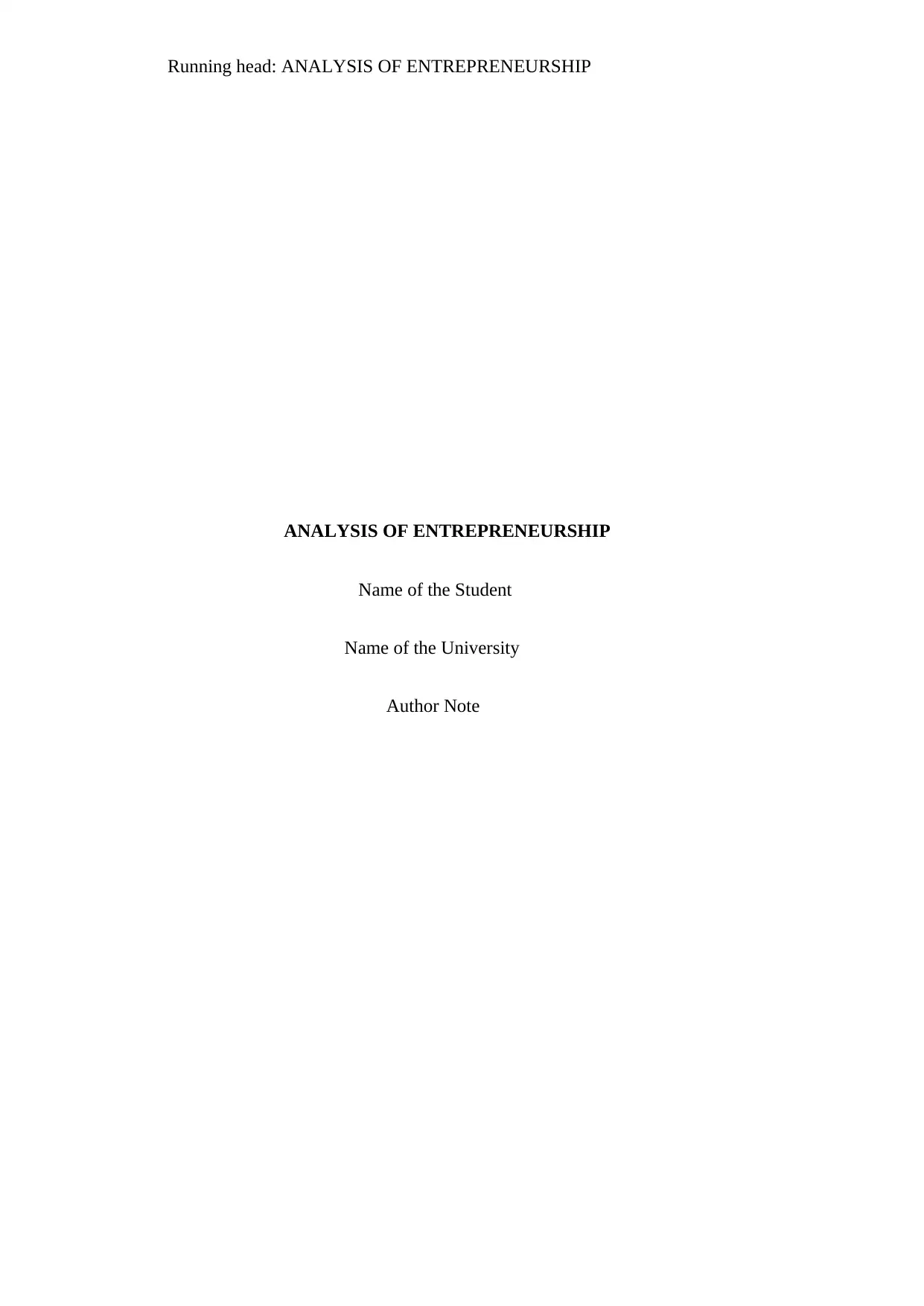
Running head: ANALYSIS OF ENTREPRENEURSHIP
ANALYSIS OF ENTREPRENEURSHIP
Name of the Student
Name of the University
Author Note
ANALYSIS OF ENTREPRENEURSHIP
Name of the Student
Name of the University
Author Note
Paraphrase This Document
Need a fresh take? Get an instant paraphrase of this document with our AI Paraphraser
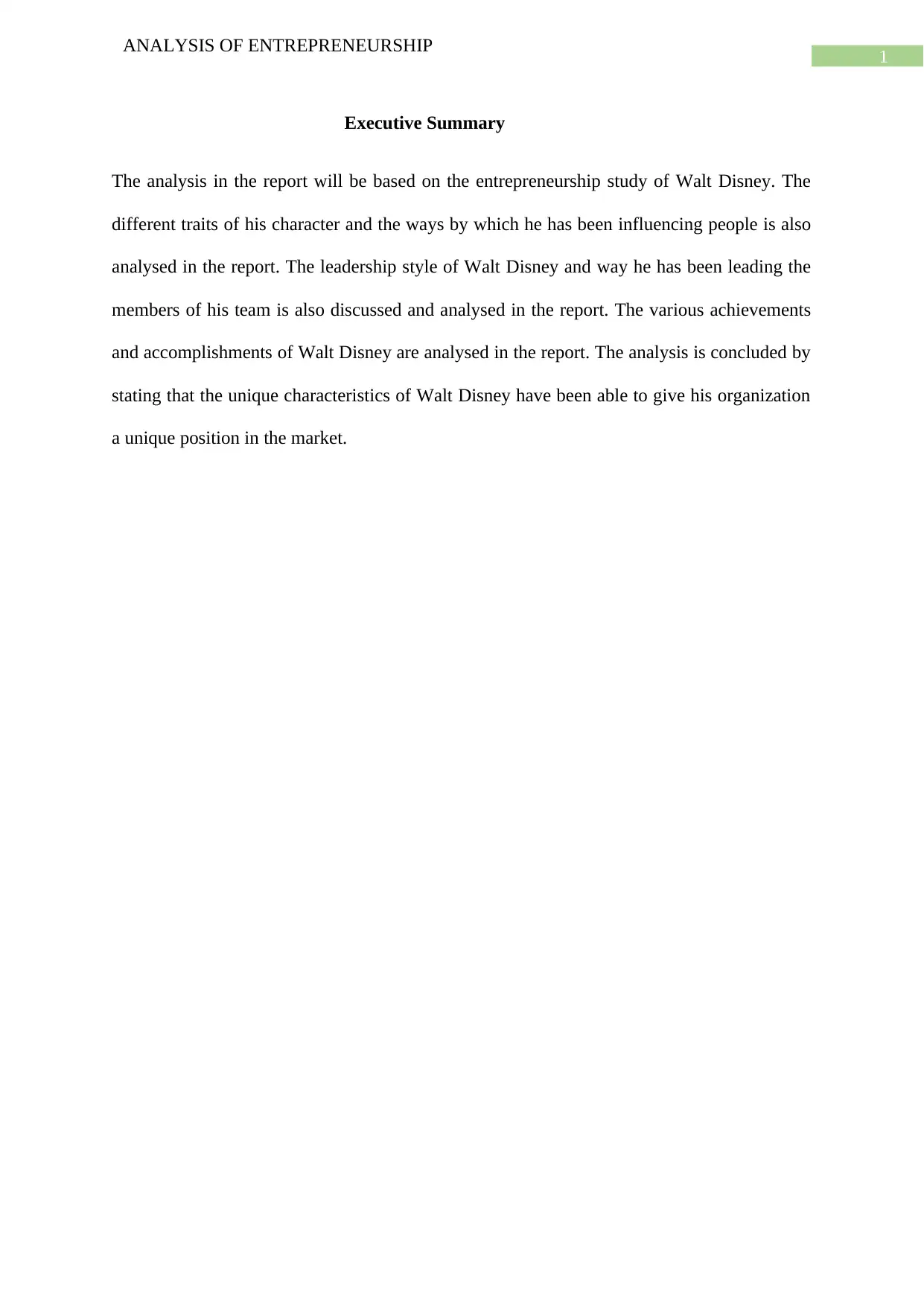
1
ANALYSIS OF ENTREPRENEURSHIP
Executive Summary
The analysis in the report will be based on the entrepreneurship study of Walt Disney. The
different traits of his character and the ways by which he has been influencing people is also
analysed in the report. The leadership style of Walt Disney and way he has been leading the
members of his team is also discussed and analysed in the report. The various achievements
and accomplishments of Walt Disney are analysed in the report. The analysis is concluded by
stating that the unique characteristics of Walt Disney have been able to give his organization
a unique position in the market.
ANALYSIS OF ENTREPRENEURSHIP
Executive Summary
The analysis in the report will be based on the entrepreneurship study of Walt Disney. The
different traits of his character and the ways by which he has been influencing people is also
analysed in the report. The leadership style of Walt Disney and way he has been leading the
members of his team is also discussed and analysed in the report. The various achievements
and accomplishments of Walt Disney are analysed in the report. The analysis is concluded by
stating that the unique characteristics of Walt Disney have been able to give his organization
a unique position in the market.
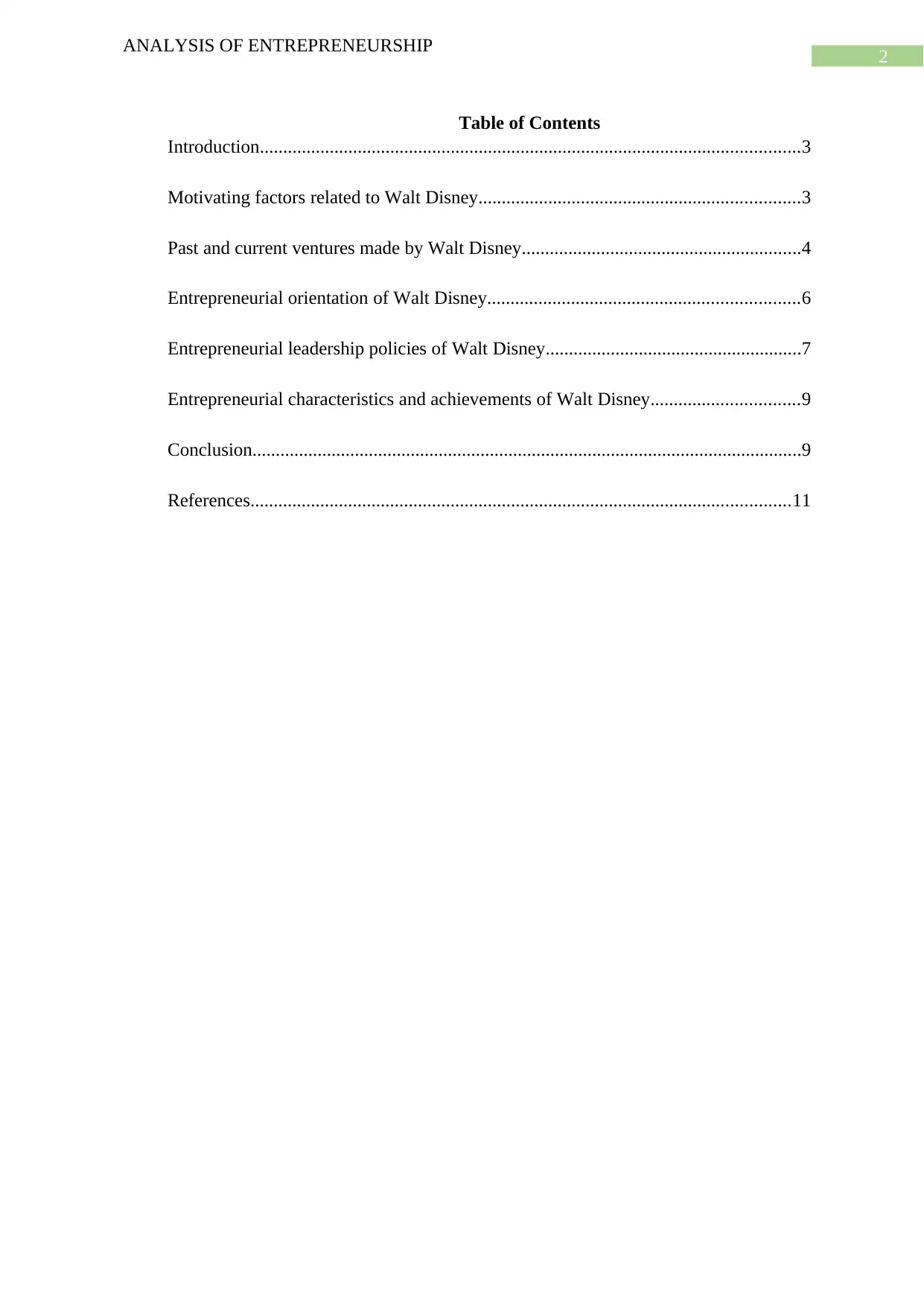
2
ANALYSIS OF ENTREPRENEURSHIP
Table of Contents
Introduction....................................................................................................................3
Motivating factors related to Walt Disney.....................................................................3
Past and current ventures made by Walt Disney............................................................4
Entrepreneurial orientation of Walt Disney...................................................................6
Entrepreneurial leadership policies of Walt Disney.......................................................7
Entrepreneurial characteristics and achievements of Walt Disney................................9
Conclusion......................................................................................................................9
References....................................................................................................................11
ANALYSIS OF ENTREPRENEURSHIP
Table of Contents
Introduction....................................................................................................................3
Motivating factors related to Walt Disney.....................................................................3
Past and current ventures made by Walt Disney............................................................4
Entrepreneurial orientation of Walt Disney...................................................................6
Entrepreneurial leadership policies of Walt Disney.......................................................7
Entrepreneurial characteristics and achievements of Walt Disney................................9
Conclusion......................................................................................................................9
References....................................................................................................................11
⊘ This is a preview!⊘
Do you want full access?
Subscribe today to unlock all pages.

Trusted by 1+ million students worldwide
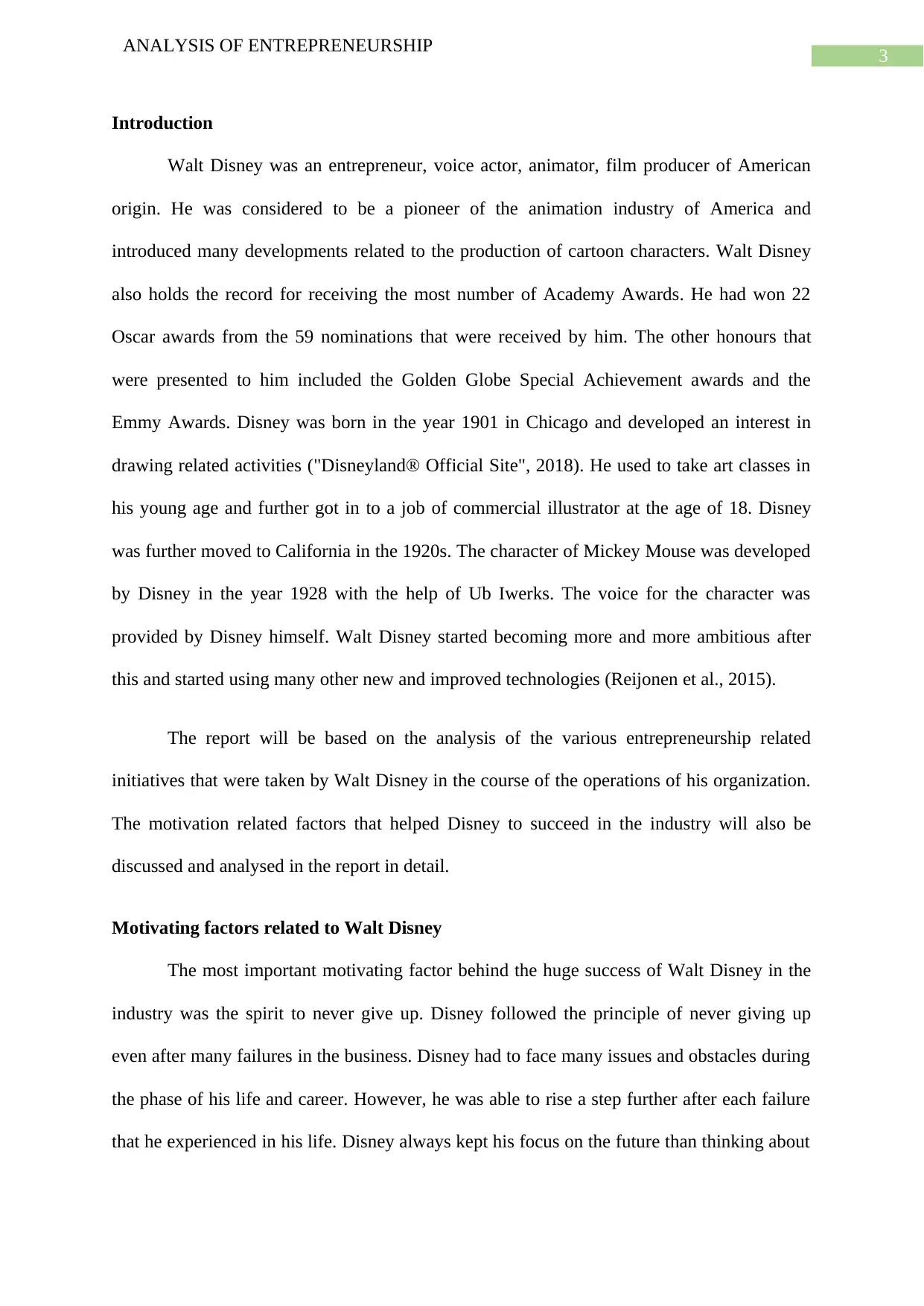
3
ANALYSIS OF ENTREPRENEURSHIP
Introduction
Walt Disney was an entrepreneur, voice actor, animator, film producer of American
origin. He was considered to be a pioneer of the animation industry of America and
introduced many developments related to the production of cartoon characters. Walt Disney
also holds the record for receiving the most number of Academy Awards. He had won 22
Oscar awards from the 59 nominations that were received by him. The other honours that
were presented to him included the Golden Globe Special Achievement awards and the
Emmy Awards. Disney was born in the year 1901 in Chicago and developed an interest in
drawing related activities ("Disneyland® Official Site", 2018). He used to take art classes in
his young age and further got in to a job of commercial illustrator at the age of 18. Disney
was further moved to California in the 1920s. The character of Mickey Mouse was developed
by Disney in the year 1928 with the help of Ub Iwerks. The voice for the character was
provided by Disney himself. Walt Disney started becoming more and more ambitious after
this and started using many other new and improved technologies (Reijonen et al., 2015).
The report will be based on the analysis of the various entrepreneurship related
initiatives that were taken by Walt Disney in the course of the operations of his organization.
The motivation related factors that helped Disney to succeed in the industry will also be
discussed and analysed in the report in detail.
Motivating factors related to Walt Disney
The most important motivating factor behind the huge success of Walt Disney in the
industry was the spirit to never give up. Disney followed the principle of never giving up
even after many failures in the business. Disney had to face many issues and obstacles during
the phase of his life and career. However, he was able to rise a step further after each failure
that he experienced in his life. Disney always kept his focus on the future than thinking about
ANALYSIS OF ENTREPRENEURSHIP
Introduction
Walt Disney was an entrepreneur, voice actor, animator, film producer of American
origin. He was considered to be a pioneer of the animation industry of America and
introduced many developments related to the production of cartoon characters. Walt Disney
also holds the record for receiving the most number of Academy Awards. He had won 22
Oscar awards from the 59 nominations that were received by him. The other honours that
were presented to him included the Golden Globe Special Achievement awards and the
Emmy Awards. Disney was born in the year 1901 in Chicago and developed an interest in
drawing related activities ("Disneyland® Official Site", 2018). He used to take art classes in
his young age and further got in to a job of commercial illustrator at the age of 18. Disney
was further moved to California in the 1920s. The character of Mickey Mouse was developed
by Disney in the year 1928 with the help of Ub Iwerks. The voice for the character was
provided by Disney himself. Walt Disney started becoming more and more ambitious after
this and started using many other new and improved technologies (Reijonen et al., 2015).
The report will be based on the analysis of the various entrepreneurship related
initiatives that were taken by Walt Disney in the course of the operations of his organization.
The motivation related factors that helped Disney to succeed in the industry will also be
discussed and analysed in the report in detail.
Motivating factors related to Walt Disney
The most important motivating factor behind the huge success of Walt Disney in the
industry was the spirit to never give up. Disney followed the principle of never giving up
even after many failures in the business. Disney had to face many issues and obstacles during
the phase of his life and career. However, he was able to rise a step further after each failure
that he experienced in his life. Disney always kept his focus on the future than thinking about
Paraphrase This Document
Need a fresh take? Get an instant paraphrase of this document with our AI Paraphraser
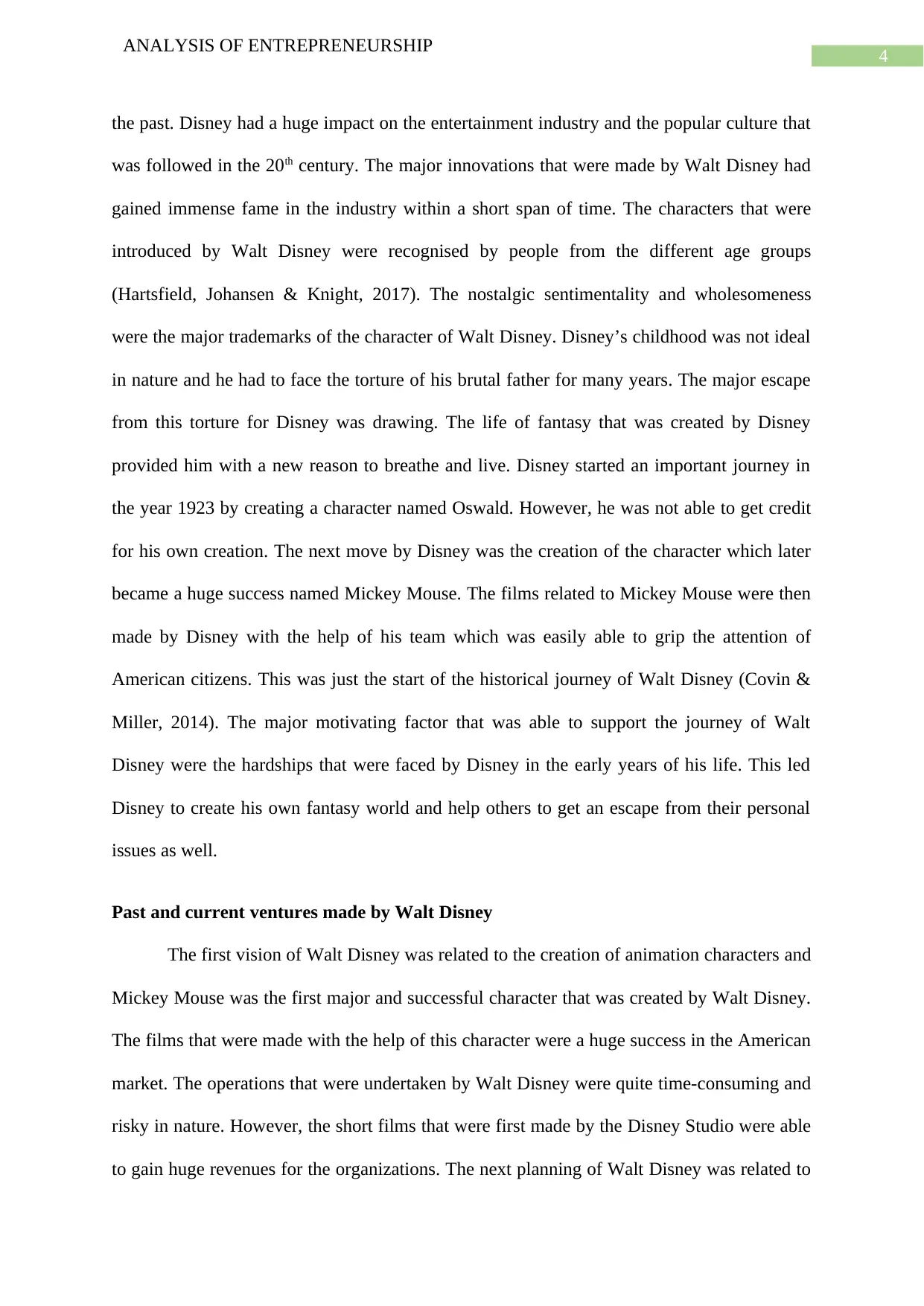
4
ANALYSIS OF ENTREPRENEURSHIP
the past. Disney had a huge impact on the entertainment industry and the popular culture that
was followed in the 20th century. The major innovations that were made by Walt Disney had
gained immense fame in the industry within a short span of time. The characters that were
introduced by Walt Disney were recognised by people from the different age groups
(Hartsfield, Johansen & Knight, 2017). The nostalgic sentimentality and wholesomeness
were the major trademarks of the character of Walt Disney. Disney’s childhood was not ideal
in nature and he had to face the torture of his brutal father for many years. The major escape
from this torture for Disney was drawing. The life of fantasy that was created by Disney
provided him with a new reason to breathe and live. Disney started an important journey in
the year 1923 by creating a character named Oswald. However, he was not able to get credit
for his own creation. The next move by Disney was the creation of the character which later
became a huge success named Mickey Mouse. The films related to Mickey Mouse were then
made by Disney with the help of his team which was easily able to grip the attention of
American citizens. This was just the start of the historical journey of Walt Disney (Covin &
Miller, 2014). The major motivating factor that was able to support the journey of Walt
Disney were the hardships that were faced by Disney in the early years of his life. This led
Disney to create his own fantasy world and help others to get an escape from their personal
issues as well.
Past and current ventures made by Walt Disney
The first vision of Walt Disney was related to the creation of animation characters and
Mickey Mouse was the first major and successful character that was created by Walt Disney.
The films that were made with the help of this character were a huge success in the American
market. The operations that were undertaken by Walt Disney were quite time-consuming and
risky in nature. However, the short films that were first made by the Disney Studio were able
to gain huge revenues for the organizations. The next planning of Walt Disney was related to
ANALYSIS OF ENTREPRENEURSHIP
the past. Disney had a huge impact on the entertainment industry and the popular culture that
was followed in the 20th century. The major innovations that were made by Walt Disney had
gained immense fame in the industry within a short span of time. The characters that were
introduced by Walt Disney were recognised by people from the different age groups
(Hartsfield, Johansen & Knight, 2017). The nostalgic sentimentality and wholesomeness
were the major trademarks of the character of Walt Disney. Disney’s childhood was not ideal
in nature and he had to face the torture of his brutal father for many years. The major escape
from this torture for Disney was drawing. The life of fantasy that was created by Disney
provided him with a new reason to breathe and live. Disney started an important journey in
the year 1923 by creating a character named Oswald. However, he was not able to get credit
for his own creation. The next move by Disney was the creation of the character which later
became a huge success named Mickey Mouse. The films related to Mickey Mouse were then
made by Disney with the help of his team which was easily able to grip the attention of
American citizens. This was just the start of the historical journey of Walt Disney (Covin &
Miller, 2014). The major motivating factor that was able to support the journey of Walt
Disney were the hardships that were faced by Disney in the early years of his life. This led
Disney to create his own fantasy world and help others to get an escape from their personal
issues as well.
Past and current ventures made by Walt Disney
The first vision of Walt Disney was related to the creation of animation characters and
Mickey Mouse was the first major and successful character that was created by Walt Disney.
The films that were made with the help of this character were a huge success in the American
market. The operations that were undertaken by Walt Disney were quite time-consuming and
risky in nature. However, the short films that were first made by the Disney Studio were able
to gain huge revenues for the organizations. The next planning of Walt Disney was related to
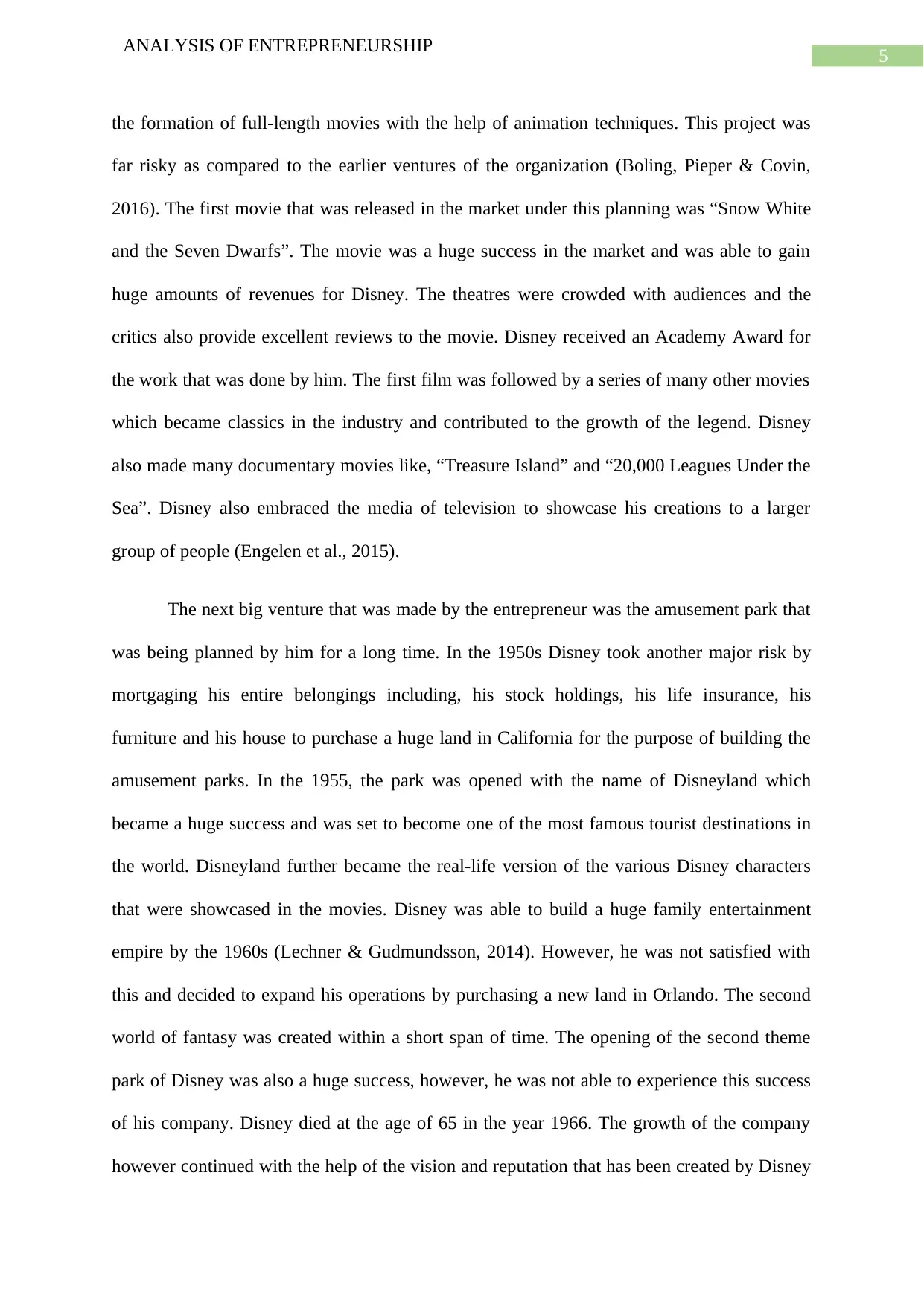
5
ANALYSIS OF ENTREPRENEURSHIP
the formation of full-length movies with the help of animation techniques. This project was
far risky as compared to the earlier ventures of the organization (Boling, Pieper & Covin,
2016). The first movie that was released in the market under this planning was “Snow White
and the Seven Dwarfs”. The movie was a huge success in the market and was able to gain
huge amounts of revenues for Disney. The theatres were crowded with audiences and the
critics also provide excellent reviews to the movie. Disney received an Academy Award for
the work that was done by him. The first film was followed by a series of many other movies
which became classics in the industry and contributed to the growth of the legend. Disney
also made many documentary movies like, “Treasure Island” and “20,000 Leagues Under the
Sea”. Disney also embraced the media of television to showcase his creations to a larger
group of people (Engelen et al., 2015).
The next big venture that was made by the entrepreneur was the amusement park that
was being planned by him for a long time. In the 1950s Disney took another major risk by
mortgaging his entire belongings including, his stock holdings, his life insurance, his
furniture and his house to purchase a huge land in California for the purpose of building the
amusement parks. In the 1955, the park was opened with the name of Disneyland which
became a huge success and was set to become one of the most famous tourist destinations in
the world. Disneyland further became the real-life version of the various Disney characters
that were showcased in the movies. Disney was able to build a huge family entertainment
empire by the 1960s (Lechner & Gudmundsson, 2014). However, he was not satisfied with
this and decided to expand his operations by purchasing a new land in Orlando. The second
world of fantasy was created within a short span of time. The opening of the second theme
park of Disney was also a huge success, however, he was not able to experience this success
of his company. Disney died at the age of 65 in the year 1966. The growth of the company
however continued with the help of the vision and reputation that has been created by Disney
ANALYSIS OF ENTREPRENEURSHIP
the formation of full-length movies with the help of animation techniques. This project was
far risky as compared to the earlier ventures of the organization (Boling, Pieper & Covin,
2016). The first movie that was released in the market under this planning was “Snow White
and the Seven Dwarfs”. The movie was a huge success in the market and was able to gain
huge amounts of revenues for Disney. The theatres were crowded with audiences and the
critics also provide excellent reviews to the movie. Disney received an Academy Award for
the work that was done by him. The first film was followed by a series of many other movies
which became classics in the industry and contributed to the growth of the legend. Disney
also made many documentary movies like, “Treasure Island” and “20,000 Leagues Under the
Sea”. Disney also embraced the media of television to showcase his creations to a larger
group of people (Engelen et al., 2015).
The next big venture that was made by the entrepreneur was the amusement park that
was being planned by him for a long time. In the 1950s Disney took another major risk by
mortgaging his entire belongings including, his stock holdings, his life insurance, his
furniture and his house to purchase a huge land in California for the purpose of building the
amusement parks. In the 1955, the park was opened with the name of Disneyland which
became a huge success and was set to become one of the most famous tourist destinations in
the world. Disneyland further became the real-life version of the various Disney characters
that were showcased in the movies. Disney was able to build a huge family entertainment
empire by the 1960s (Lechner & Gudmundsson, 2014). However, he was not satisfied with
this and decided to expand his operations by purchasing a new land in Orlando. The second
world of fantasy was created within a short span of time. The opening of the second theme
park of Disney was also a huge success, however, he was not able to experience this success
of his company. Disney died at the age of 65 in the year 1966. The growth of the company
however continued with the help of the vision and reputation that has been created by Disney
⊘ This is a preview!⊘
Do you want full access?
Subscribe today to unlock all pages.

Trusted by 1+ million students worldwide
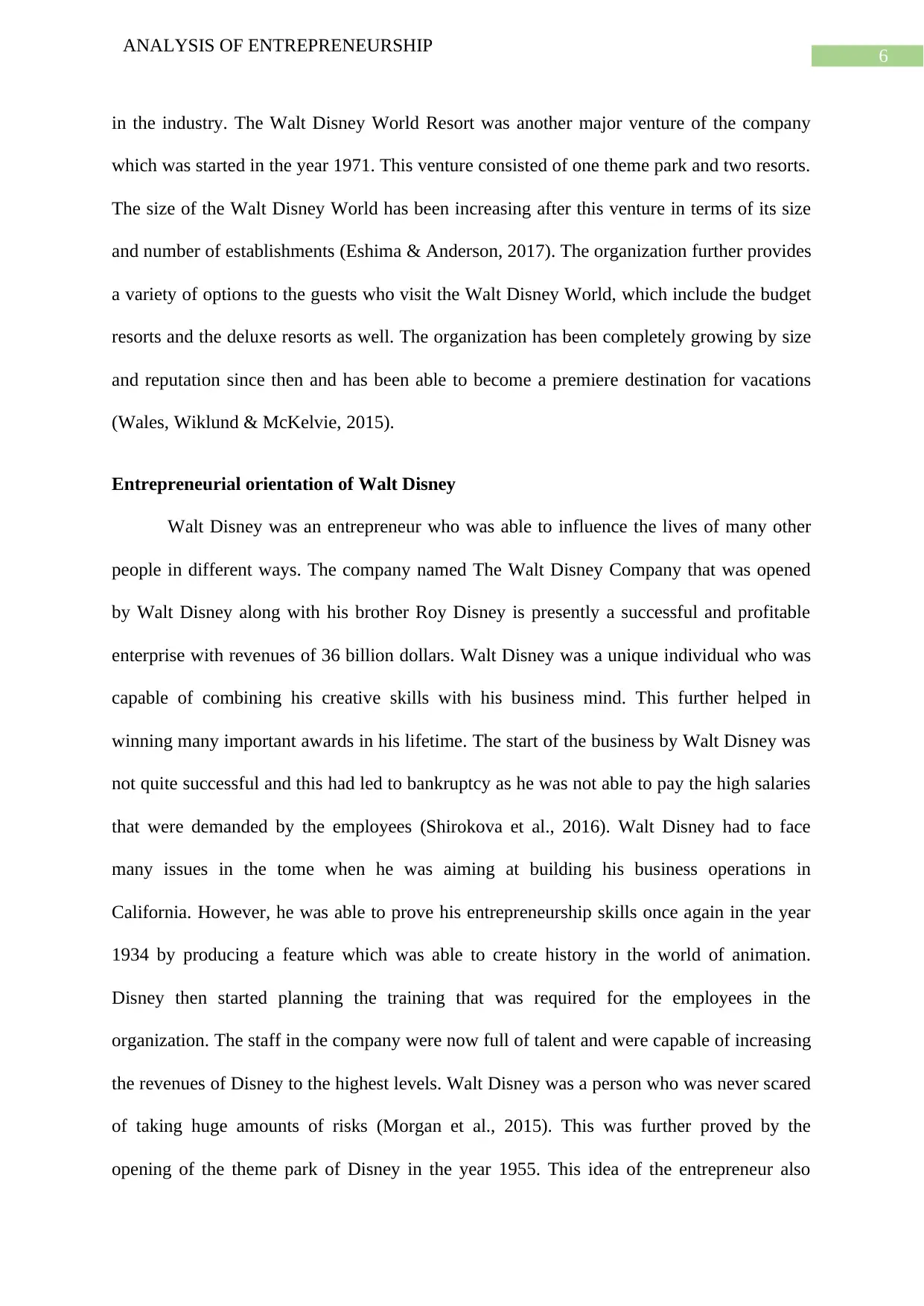
6
ANALYSIS OF ENTREPRENEURSHIP
in the industry. The Walt Disney World Resort was another major venture of the company
which was started in the year 1971. This venture consisted of one theme park and two resorts.
The size of the Walt Disney World has been increasing after this venture in terms of its size
and number of establishments (Eshima & Anderson, 2017). The organization further provides
a variety of options to the guests who visit the Walt Disney World, which include the budget
resorts and the deluxe resorts as well. The organization has been completely growing by size
and reputation since then and has been able to become a premiere destination for vacations
(Wales, Wiklund & McKelvie, 2015).
Entrepreneurial orientation of Walt Disney
Walt Disney was an entrepreneur who was able to influence the lives of many other
people in different ways. The company named The Walt Disney Company that was opened
by Walt Disney along with his brother Roy Disney is presently a successful and profitable
enterprise with revenues of 36 billion dollars. Walt Disney was a unique individual who was
capable of combining his creative skills with his business mind. This further helped in
winning many important awards in his lifetime. The start of the business by Walt Disney was
not quite successful and this had led to bankruptcy as he was not able to pay the high salaries
that were demanded by the employees (Shirokova et al., 2016). Walt Disney had to face
many issues in the tome when he was aiming at building his business operations in
California. However, he was able to prove his entrepreneurship skills once again in the year
1934 by producing a feature which was able to create history in the world of animation.
Disney then started planning the training that was required for the employees in the
organization. The staff in the company were now full of talent and were capable of increasing
the revenues of Disney to the highest levels. Walt Disney was a person who was never scared
of taking huge amounts of risks (Morgan et al., 2015). This was further proved by the
opening of the theme park of Disney in the year 1955. This idea of the entrepreneur also
ANALYSIS OF ENTREPRENEURSHIP
in the industry. The Walt Disney World Resort was another major venture of the company
which was started in the year 1971. This venture consisted of one theme park and two resorts.
The size of the Walt Disney World has been increasing after this venture in terms of its size
and number of establishments (Eshima & Anderson, 2017). The organization further provides
a variety of options to the guests who visit the Walt Disney World, which include the budget
resorts and the deluxe resorts as well. The organization has been completely growing by size
and reputation since then and has been able to become a premiere destination for vacations
(Wales, Wiklund & McKelvie, 2015).
Entrepreneurial orientation of Walt Disney
Walt Disney was an entrepreneur who was able to influence the lives of many other
people in different ways. The company named The Walt Disney Company that was opened
by Walt Disney along with his brother Roy Disney is presently a successful and profitable
enterprise with revenues of 36 billion dollars. Walt Disney was a unique individual who was
capable of combining his creative skills with his business mind. This further helped in
winning many important awards in his lifetime. The start of the business by Walt Disney was
not quite successful and this had led to bankruptcy as he was not able to pay the high salaries
that were demanded by the employees (Shirokova et al., 2016). Walt Disney had to face
many issues in the tome when he was aiming at building his business operations in
California. However, he was able to prove his entrepreneurship skills once again in the year
1934 by producing a feature which was able to create history in the world of animation.
Disney then started planning the training that was required for the employees in the
organization. The staff in the company were now full of talent and were capable of increasing
the revenues of Disney to the highest levels. Walt Disney was a person who was never scared
of taking huge amounts of risks (Morgan et al., 2015). This was further proved by the
opening of the theme park of Disney in the year 1955. This idea of the entrepreneur also
Paraphrase This Document
Need a fresh take? Get an instant paraphrase of this document with our AI Paraphraser
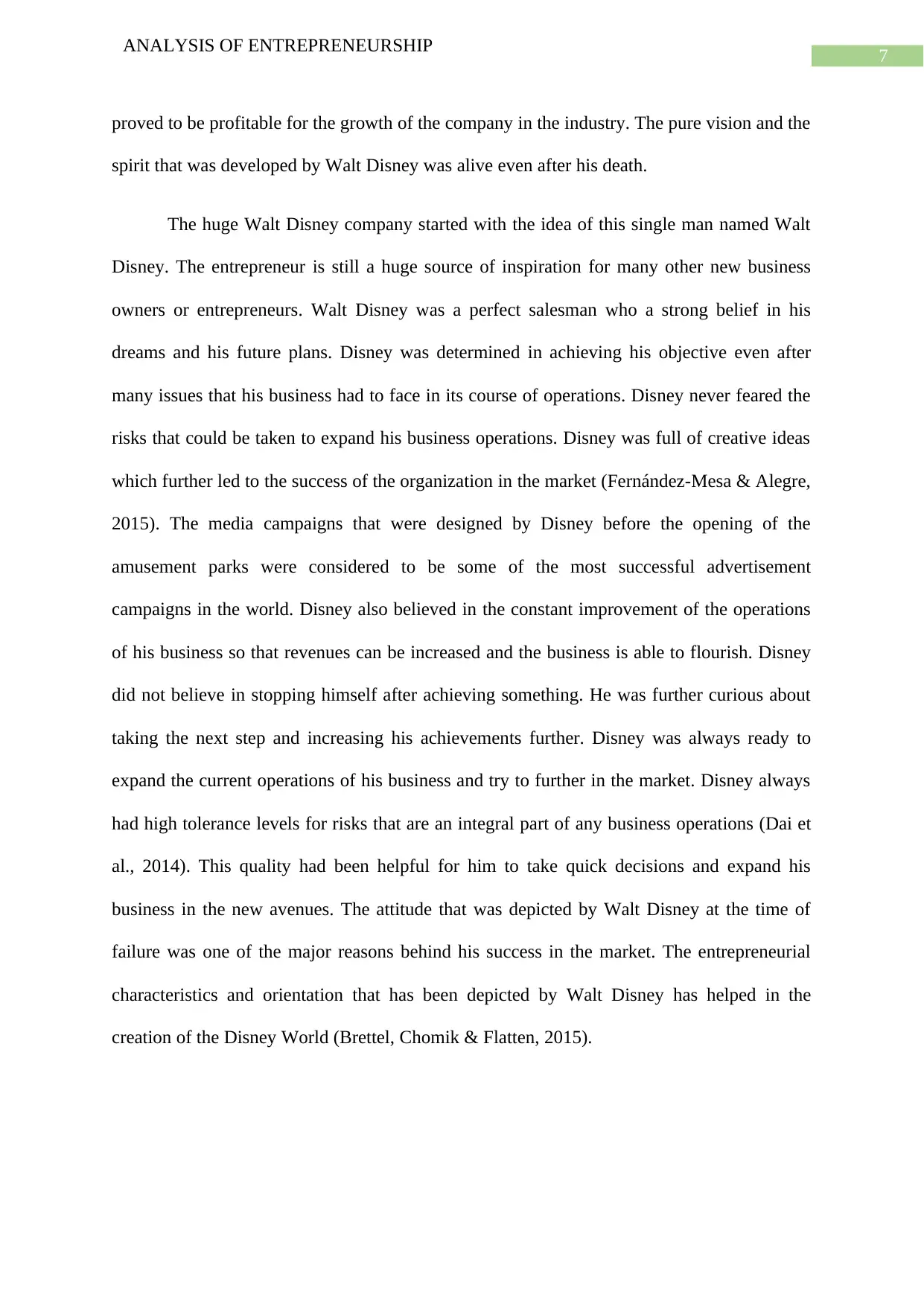
7
ANALYSIS OF ENTREPRENEURSHIP
proved to be profitable for the growth of the company in the industry. The pure vision and the
spirit that was developed by Walt Disney was alive even after his death.
The huge Walt Disney company started with the idea of this single man named Walt
Disney. The entrepreneur is still a huge source of inspiration for many other new business
owners or entrepreneurs. Walt Disney was a perfect salesman who a strong belief in his
dreams and his future plans. Disney was determined in achieving his objective even after
many issues that his business had to face in its course of operations. Disney never feared the
risks that could be taken to expand his business operations. Disney was full of creative ideas
which further led to the success of the organization in the market (Fernández-Mesa & Alegre,
2015). The media campaigns that were designed by Disney before the opening of the
amusement parks were considered to be some of the most successful advertisement
campaigns in the world. Disney also believed in the constant improvement of the operations
of his business so that revenues can be increased and the business is able to flourish. Disney
did not believe in stopping himself after achieving something. He was further curious about
taking the next step and increasing his achievements further. Disney was always ready to
expand the current operations of his business and try to further in the market. Disney always
had high tolerance levels for risks that are an integral part of any business operations (Dai et
al., 2014). This quality had been helpful for him to take quick decisions and expand his
business in the new avenues. The attitude that was depicted by Walt Disney at the time of
failure was one of the major reasons behind his success in the market. The entrepreneurial
characteristics and orientation that has been depicted by Walt Disney has helped in the
creation of the Disney World (Brettel, Chomik & Flatten, 2015).
ANALYSIS OF ENTREPRENEURSHIP
proved to be profitable for the growth of the company in the industry. The pure vision and the
spirit that was developed by Walt Disney was alive even after his death.
The huge Walt Disney company started with the idea of this single man named Walt
Disney. The entrepreneur is still a huge source of inspiration for many other new business
owners or entrepreneurs. Walt Disney was a perfect salesman who a strong belief in his
dreams and his future plans. Disney was determined in achieving his objective even after
many issues that his business had to face in its course of operations. Disney never feared the
risks that could be taken to expand his business operations. Disney was full of creative ideas
which further led to the success of the organization in the market (Fernández-Mesa & Alegre,
2015). The media campaigns that were designed by Disney before the opening of the
amusement parks were considered to be some of the most successful advertisement
campaigns in the world. Disney also believed in the constant improvement of the operations
of his business so that revenues can be increased and the business is able to flourish. Disney
did not believe in stopping himself after achieving something. He was further curious about
taking the next step and increasing his achievements further. Disney was always ready to
expand the current operations of his business and try to further in the market. Disney always
had high tolerance levels for risks that are an integral part of any business operations (Dai et
al., 2014). This quality had been helpful for him to take quick decisions and expand his
business in the new avenues. The attitude that was depicted by Walt Disney at the time of
failure was one of the major reasons behind his success in the market. The entrepreneurial
characteristics and orientation that has been depicted by Walt Disney has helped in the
creation of the Disney World (Brettel, Chomik & Flatten, 2015).
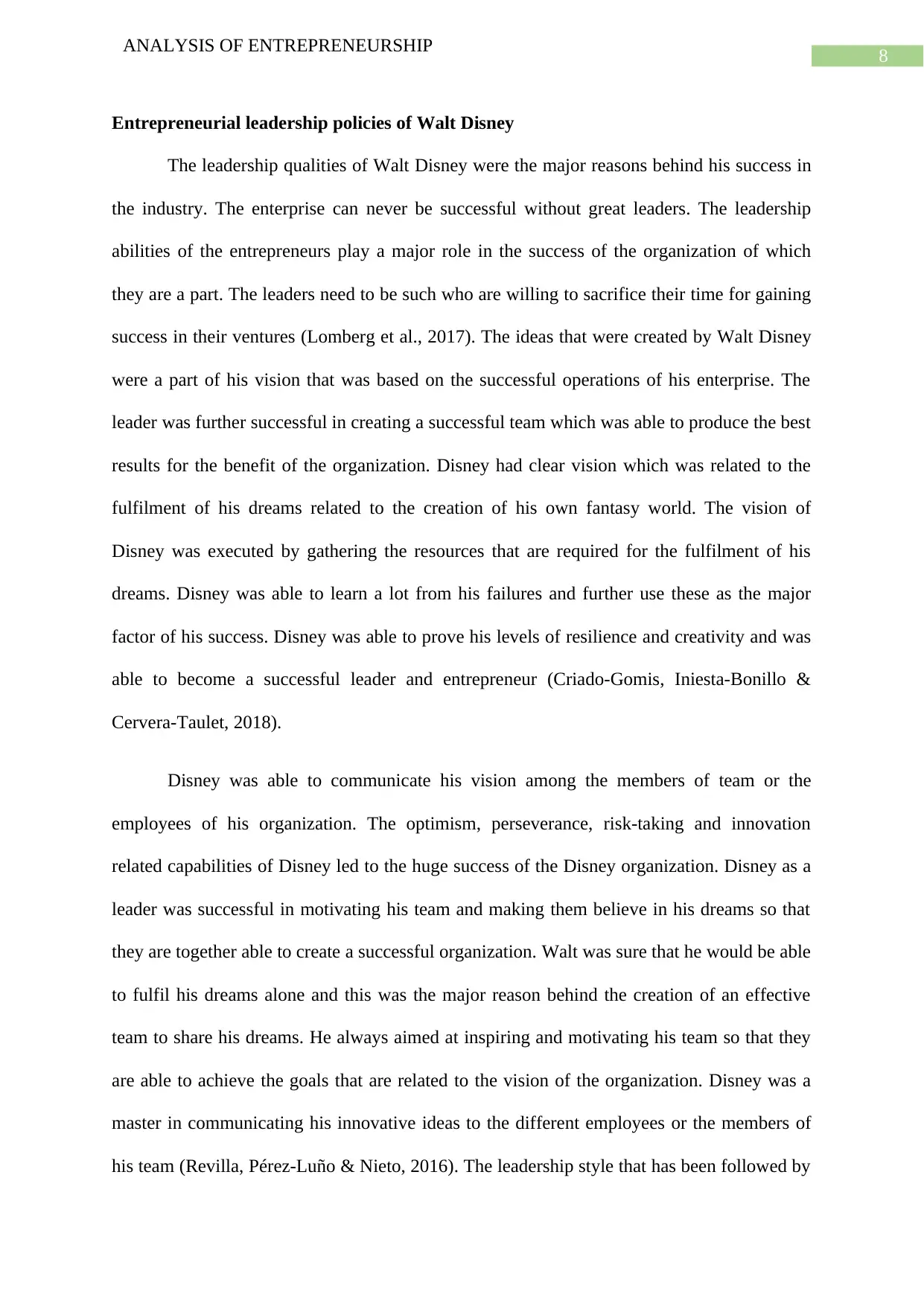
8
ANALYSIS OF ENTREPRENEURSHIP
Entrepreneurial leadership policies of Walt Disney
The leadership qualities of Walt Disney were the major reasons behind his success in
the industry. The enterprise can never be successful without great leaders. The leadership
abilities of the entrepreneurs play a major role in the success of the organization of which
they are a part. The leaders need to be such who are willing to sacrifice their time for gaining
success in their ventures (Lomberg et al., 2017). The ideas that were created by Walt Disney
were a part of his vision that was based on the successful operations of his enterprise. The
leader was further successful in creating a successful team which was able to produce the best
results for the benefit of the organization. Disney had clear vision which was related to the
fulfilment of his dreams related to the creation of his own fantasy world. The vision of
Disney was executed by gathering the resources that are required for the fulfilment of his
dreams. Disney was able to learn a lot from his failures and further use these as the major
factor of his success. Disney was able to prove his levels of resilience and creativity and was
able to become a successful leader and entrepreneur (Criado-Gomis, Iniesta-Bonillo &
Cervera-Taulet, 2018).
Disney was able to communicate his vision among the members of team or the
employees of his organization. The optimism, perseverance, risk-taking and innovation
related capabilities of Disney led to the huge success of the Disney organization. Disney as a
leader was successful in motivating his team and making them believe in his dreams so that
they are together able to create a successful organization. Walt was sure that he would be able
to fulfil his dreams alone and this was the major reason behind the creation of an effective
team to share his dreams. He always aimed at inspiring and motivating his team so that they
are able to achieve the goals that are related to the vision of the organization. Disney was a
master in communicating his innovative ideas to the different employees or the members of
his team (Revilla, Pérez-Luño & Nieto, 2016). The leadership style that has been followed by
ANALYSIS OF ENTREPRENEURSHIP
Entrepreneurial leadership policies of Walt Disney
The leadership qualities of Walt Disney were the major reasons behind his success in
the industry. The enterprise can never be successful without great leaders. The leadership
abilities of the entrepreneurs play a major role in the success of the organization of which
they are a part. The leaders need to be such who are willing to sacrifice their time for gaining
success in their ventures (Lomberg et al., 2017). The ideas that were created by Walt Disney
were a part of his vision that was based on the successful operations of his enterprise. The
leader was further successful in creating a successful team which was able to produce the best
results for the benefit of the organization. Disney had clear vision which was related to the
fulfilment of his dreams related to the creation of his own fantasy world. The vision of
Disney was executed by gathering the resources that are required for the fulfilment of his
dreams. Disney was able to learn a lot from his failures and further use these as the major
factor of his success. Disney was able to prove his levels of resilience and creativity and was
able to become a successful leader and entrepreneur (Criado-Gomis, Iniesta-Bonillo &
Cervera-Taulet, 2018).
Disney was able to communicate his vision among the members of team or the
employees of his organization. The optimism, perseverance, risk-taking and innovation
related capabilities of Disney led to the huge success of the Disney organization. Disney as a
leader was successful in motivating his team and making them believe in his dreams so that
they are together able to create a successful organization. Walt was sure that he would be able
to fulfil his dreams alone and this was the major reason behind the creation of an effective
team to share his dreams. He always aimed at inspiring and motivating his team so that they
are able to achieve the goals that are related to the vision of the organization. Disney was a
master in communicating his innovative ideas to the different employees or the members of
his team (Revilla, Pérez-Luño & Nieto, 2016). The leadership style that has been followed by
⊘ This is a preview!⊘
Do you want full access?
Subscribe today to unlock all pages.

Trusted by 1+ million students worldwide
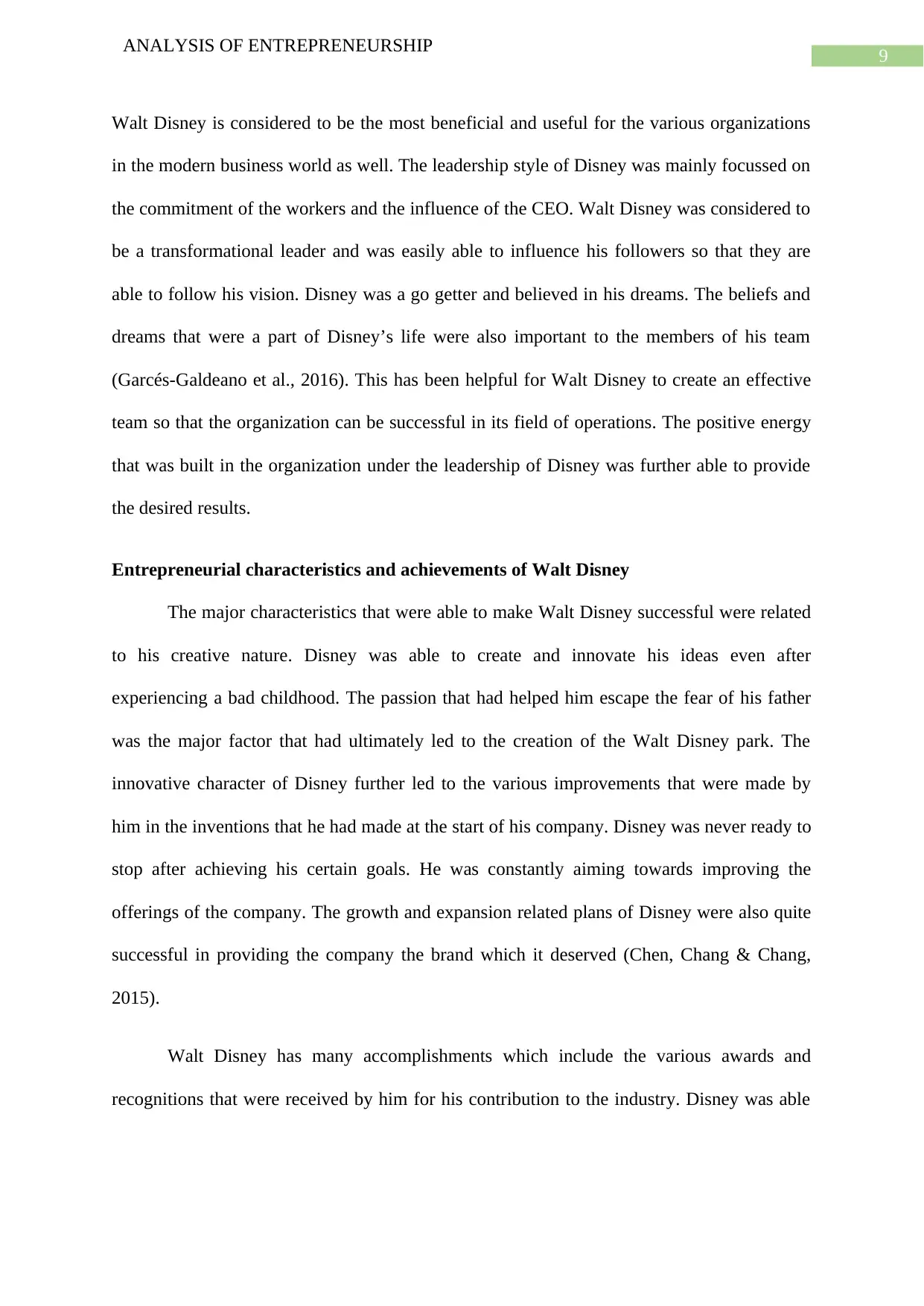
9
ANALYSIS OF ENTREPRENEURSHIP
Walt Disney is considered to be the most beneficial and useful for the various organizations
in the modern business world as well. The leadership style of Disney was mainly focussed on
the commitment of the workers and the influence of the CEO. Walt Disney was considered to
be a transformational leader and was easily able to influence his followers so that they are
able to follow his vision. Disney was a go getter and believed in his dreams. The beliefs and
dreams that were a part of Disney’s life were also important to the members of his team
(Garcés-Galdeano et al., 2016). This has been helpful for Walt Disney to create an effective
team so that the organization can be successful in its field of operations. The positive energy
that was built in the organization under the leadership of Disney was further able to provide
the desired results.
Entrepreneurial characteristics and achievements of Walt Disney
The major characteristics that were able to make Walt Disney successful were related
to his creative nature. Disney was able to create and innovate his ideas even after
experiencing a bad childhood. The passion that had helped him escape the fear of his father
was the major factor that had ultimately led to the creation of the Walt Disney park. The
innovative character of Disney further led to the various improvements that were made by
him in the inventions that he had made at the start of his company. Disney was never ready to
stop after achieving his certain goals. He was constantly aiming towards improving the
offerings of the company. The growth and expansion related plans of Disney were also quite
successful in providing the company the brand which it deserved (Chen, Chang & Chang,
2015).
Walt Disney has many accomplishments which include the various awards and
recognitions that were received by him for his contribution to the industry. Disney was able
ANALYSIS OF ENTREPRENEURSHIP
Walt Disney is considered to be the most beneficial and useful for the various organizations
in the modern business world as well. The leadership style of Disney was mainly focussed on
the commitment of the workers and the influence of the CEO. Walt Disney was considered to
be a transformational leader and was easily able to influence his followers so that they are
able to follow his vision. Disney was a go getter and believed in his dreams. The beliefs and
dreams that were a part of Disney’s life were also important to the members of his team
(Garcés-Galdeano et al., 2016). This has been helpful for Walt Disney to create an effective
team so that the organization can be successful in its field of operations. The positive energy
that was built in the organization under the leadership of Disney was further able to provide
the desired results.
Entrepreneurial characteristics and achievements of Walt Disney
The major characteristics that were able to make Walt Disney successful were related
to his creative nature. Disney was able to create and innovate his ideas even after
experiencing a bad childhood. The passion that had helped him escape the fear of his father
was the major factor that had ultimately led to the creation of the Walt Disney park. The
innovative character of Disney further led to the various improvements that were made by
him in the inventions that he had made at the start of his company. Disney was never ready to
stop after achieving his certain goals. He was constantly aiming towards improving the
offerings of the company. The growth and expansion related plans of Disney were also quite
successful in providing the company the brand which it deserved (Chen, Chang & Chang,
2015).
Walt Disney has many accomplishments which include the various awards and
recognitions that were received by him for his contribution to the industry. Disney was able
Paraphrase This Document
Need a fresh take? Get an instant paraphrase of this document with our AI Paraphraser
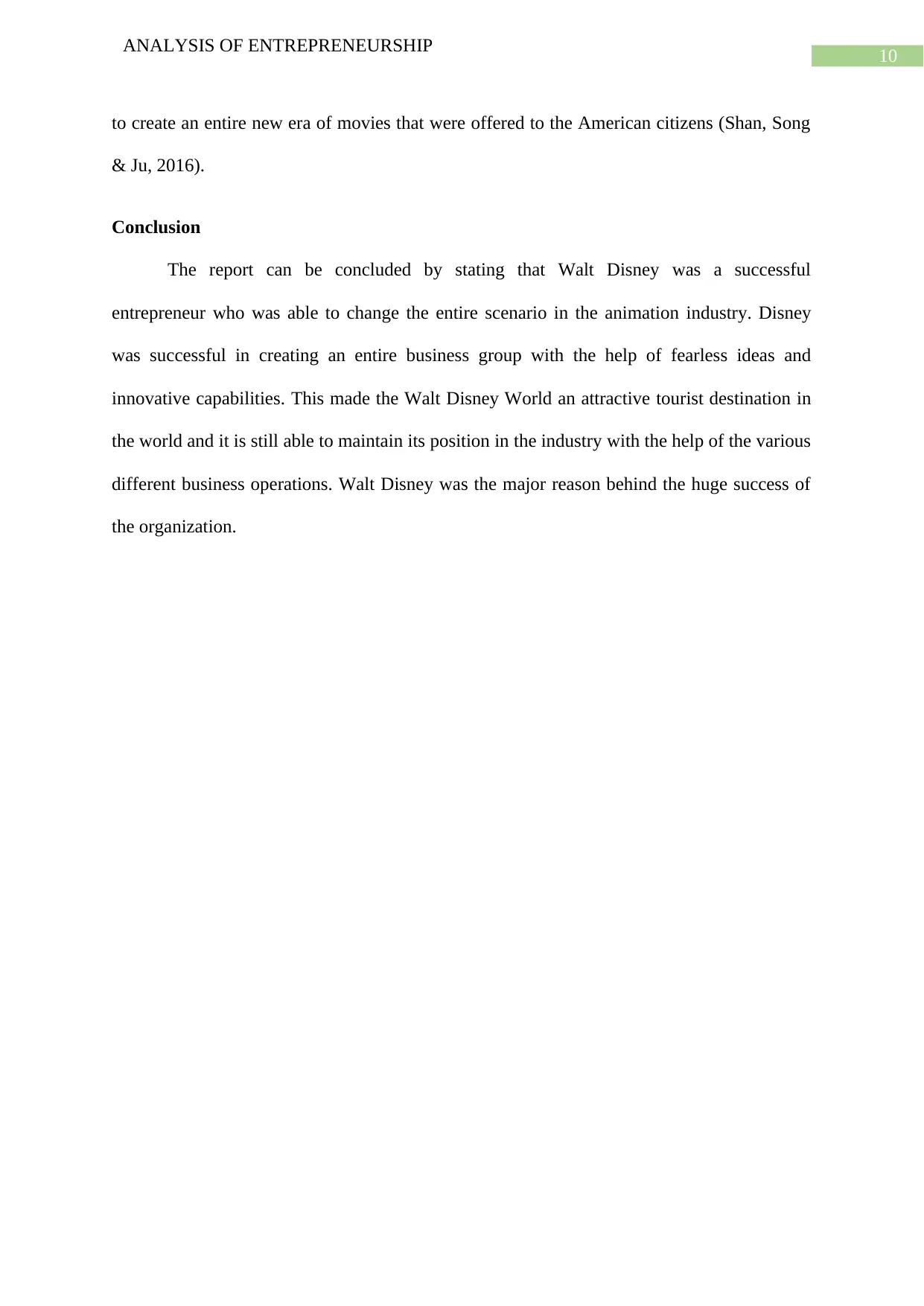
10
ANALYSIS OF ENTREPRENEURSHIP
to create an entire new era of movies that were offered to the American citizens (Shan, Song
& Ju, 2016).
Conclusion
The report can be concluded by stating that Walt Disney was a successful
entrepreneur who was able to change the entire scenario in the animation industry. Disney
was successful in creating an entire business group with the help of fearless ideas and
innovative capabilities. This made the Walt Disney World an attractive tourist destination in
the world and it is still able to maintain its position in the industry with the help of the various
different business operations. Walt Disney was the major reason behind the huge success of
the organization.
ANALYSIS OF ENTREPRENEURSHIP
to create an entire new era of movies that were offered to the American citizens (Shan, Song
& Ju, 2016).
Conclusion
The report can be concluded by stating that Walt Disney was a successful
entrepreneur who was able to change the entire scenario in the animation industry. Disney
was successful in creating an entire business group with the help of fearless ideas and
innovative capabilities. This made the Walt Disney World an attractive tourist destination in
the world and it is still able to maintain its position in the industry with the help of the various
different business operations. Walt Disney was the major reason behind the huge success of
the organization.
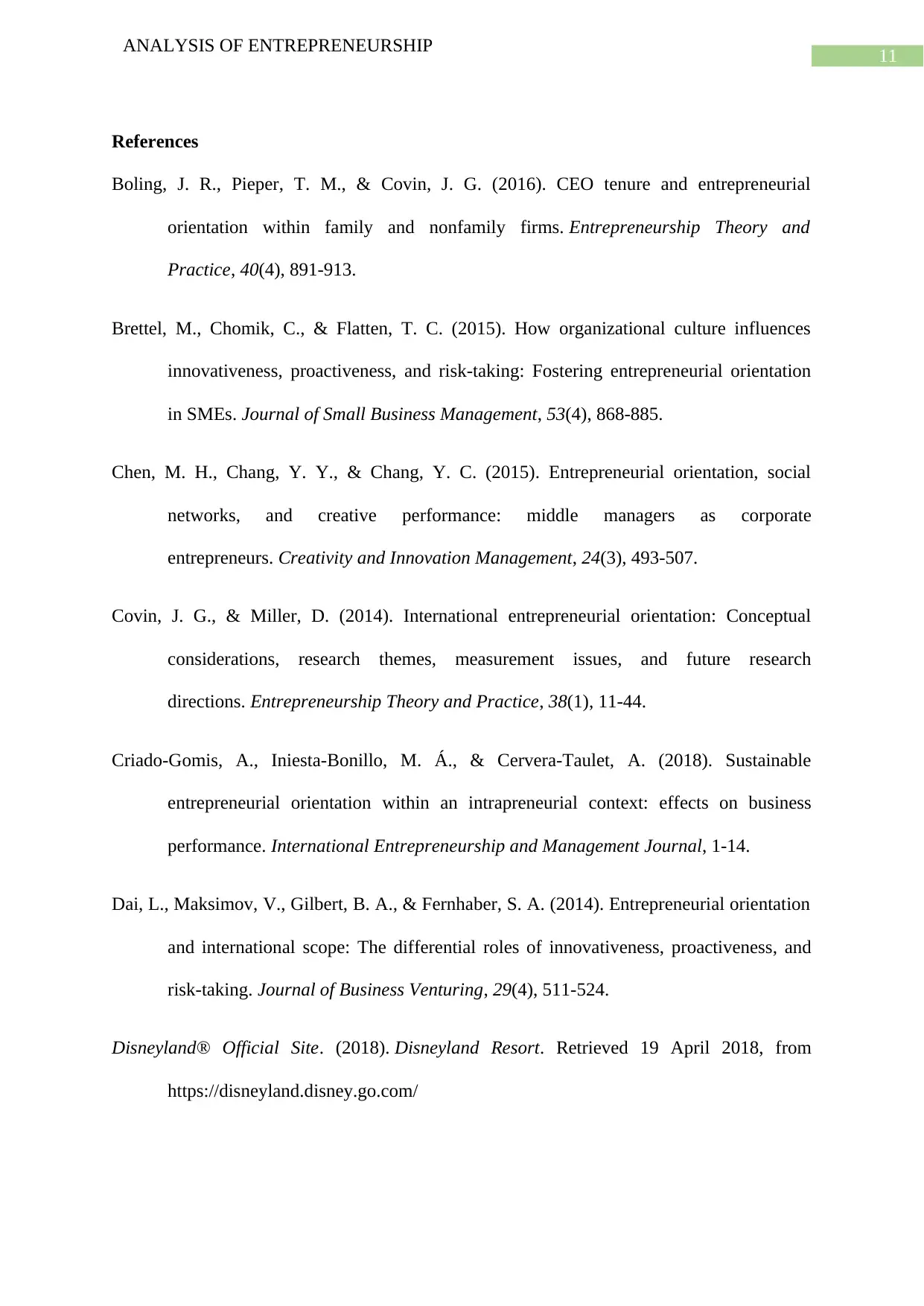
11
ANALYSIS OF ENTREPRENEURSHIP
References
Boling, J. R., Pieper, T. M., & Covin, J. G. (2016). CEO tenure and entrepreneurial
orientation within family and nonfamily firms. Entrepreneurship Theory and
Practice, 40(4), 891-913.
Brettel, M., Chomik, C., & Flatten, T. C. (2015). How organizational culture influences
innovativeness, proactiveness, and risk‐taking: Fostering entrepreneurial orientation
in SMEs. Journal of Small Business Management, 53(4), 868-885.
Chen, M. H., Chang, Y. Y., & Chang, Y. C. (2015). Entrepreneurial orientation, social
networks, and creative performance: middle managers as corporate
entrepreneurs. Creativity and Innovation Management, 24(3), 493-507.
Covin, J. G., & Miller, D. (2014). International entrepreneurial orientation: Conceptual
considerations, research themes, measurement issues, and future research
directions. Entrepreneurship Theory and Practice, 38(1), 11-44.
Criado-Gomis, A., Iniesta-Bonillo, M. Á., & Cervera-Taulet, A. (2018). Sustainable
entrepreneurial orientation within an intrapreneurial context: effects on business
performance. International Entrepreneurship and Management Journal, 1-14.
Dai, L., Maksimov, V., Gilbert, B. A., & Fernhaber, S. A. (2014). Entrepreneurial orientation
and international scope: The differential roles of innovativeness, proactiveness, and
risk-taking. Journal of Business Venturing, 29(4), 511-524.
Disneyland® Official Site. (2018). Disneyland Resort. Retrieved 19 April 2018, from
https://disneyland.disney.go.com/
ANALYSIS OF ENTREPRENEURSHIP
References
Boling, J. R., Pieper, T. M., & Covin, J. G. (2016). CEO tenure and entrepreneurial
orientation within family and nonfamily firms. Entrepreneurship Theory and
Practice, 40(4), 891-913.
Brettel, M., Chomik, C., & Flatten, T. C. (2015). How organizational culture influences
innovativeness, proactiveness, and risk‐taking: Fostering entrepreneurial orientation
in SMEs. Journal of Small Business Management, 53(4), 868-885.
Chen, M. H., Chang, Y. Y., & Chang, Y. C. (2015). Entrepreneurial orientation, social
networks, and creative performance: middle managers as corporate
entrepreneurs. Creativity and Innovation Management, 24(3), 493-507.
Covin, J. G., & Miller, D. (2014). International entrepreneurial orientation: Conceptual
considerations, research themes, measurement issues, and future research
directions. Entrepreneurship Theory and Practice, 38(1), 11-44.
Criado-Gomis, A., Iniesta-Bonillo, M. Á., & Cervera-Taulet, A. (2018). Sustainable
entrepreneurial orientation within an intrapreneurial context: effects on business
performance. International Entrepreneurship and Management Journal, 1-14.
Dai, L., Maksimov, V., Gilbert, B. A., & Fernhaber, S. A. (2014). Entrepreneurial orientation
and international scope: The differential roles of innovativeness, proactiveness, and
risk-taking. Journal of Business Venturing, 29(4), 511-524.
Disneyland® Official Site. (2018). Disneyland Resort. Retrieved 19 April 2018, from
https://disneyland.disney.go.com/
⊘ This is a preview!⊘
Do you want full access?
Subscribe today to unlock all pages.

Trusted by 1+ million students worldwide
1 out of 14
Related Documents
Your All-in-One AI-Powered Toolkit for Academic Success.
+13062052269
info@desklib.com
Available 24*7 on WhatsApp / Email
![[object Object]](/_next/static/media/star-bottom.7253800d.svg)
Unlock your academic potential
Copyright © 2020–2025 A2Z Services. All Rights Reserved. Developed and managed by ZUCOL.





